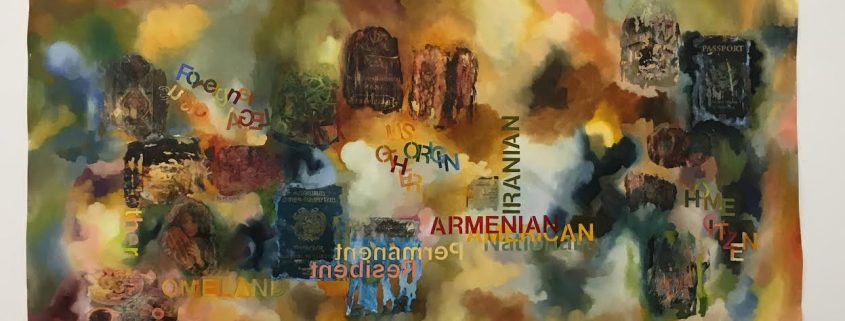Roski senior creates art on international identity
What is home? Is it a place, person or mentality? Argineh Zadoorian, a senior majoring in art, invited viewers to ask this question in her latest exhibit It Feels Like Home.
The Macomber Travel Grant, which is awarded to undergraduate Roski students to do research-based travel and create new art, allowed Zadoorian to travel to Armenia. During her trip, she conducted surveys with international students about the process of assimilation and finding a home. After speaking to international students in both Armenia and at USC, Zadoorian found the inspiration she needed to create her exhibit.
One example of such inspiration can be found in her abstract paintings. The paintings are an array of images in which texts from various surveys are written and mixed with varying color palettes.
Zadoorian’s attention to detail is remarkable — the use of handwritten text resembles not only the intimacy of using a personal diary, but also the discomfort that comes with revealing personal details. Furthermore, her use of color, such as the bold blue that was popular in her hometown and the Persian characters, reflect the complexity of each person’s experience and identity.
“The kind of handwriting that I use is intentional; it’s not my handwriting,” Zadoorian said. “It’s the handwriting that I’m not comfortable with, and the reason behind it is that I wanted to place myself in their position, being the other, while looking at other people’s stories.”
Zadoorian comes from a mixed background herself. As an Iranian Armenian woman creating art in America, Zadoorian has discovered her own sense of identity through the power of art. Her identity as Armenian, refugee and artist is printed in bold Helvetica letters against a colorful background of paint strokes. Hidden beneath the strokes are visual manifestations of her heritage — Persian rugs, dried fruits and a photo of herself holding traditional Armenian bread.
“Coming from a different culture background, having all these nationalities and being an artist helps me to be able to express myself and to bring whatever I have from my past to my present,” Zadoorian said. “If I was doing something else I’m unsure if I would be comfortable doing that.”
The exhibit is a conglomeration of different art mediums, such as video and carpentry, which play off the idea that every person has many different identities. Notable works stemming from that concept include two videos projected on the east and west walls.
One shows Zadoorian’s past, present and future. The wall shows the overflow of emotions individuals have when reconnecting with their past and conjuring memories, as well as the journeys they take in the hope of coming to terms with past and present identities.
This recognition of heritage is also exemplified in the other video and accompanying trinket box on display — in the video, the viewer goes inside a carved box in which Zadoorian’s heritage is represented by her personal possessions. From the Persian rug to the eyeliner worn in her hometown to woven dolls, Zadoorian reminds us that home is not a place, but the things we carry around with us that shape our identity.
At the end of an array of paintings is a self-portrait. The painting, however, does not capture Zadoorian’s personal experience with identity — instead, it represents of all the individuals Zadoorian surveyed and their feelings of assimilation and alienation. In it, Zadoorian is shown with a face of confusion and disappointment, symbolic of the expressions her peers had told her when they were asked by others about their feeling of belonging in their current communities.
“I would get their impression of when they feel like they are assimilated in an environment or when they feel like they are the other,” Zadoorian said when conducting the survey. “This [self-portrait] is the look that I usually get from people [about assimilation], and I am just trying to give it back to them, the viewer.”

